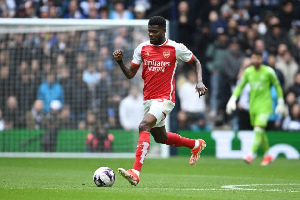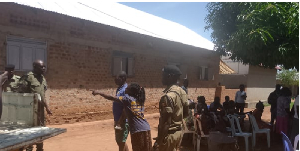Regional News of Tuesday, 24 July 2018
Source: Jeorge Wilson Kingson
2018 Mepe Afenorto festival launched
The Chiefs and people of Mepe Traditional Area in the Volta Region have launched the 64th edition of the annual Afenorto Festival.
The event took place at a colourful ceremony at the Holiday Inn hotel in Accra on Wednesday, July 12, 2018.
Afenorto, meaning ‘period of rest at home’ is a celebration by the people of Mepe usually between the month of July and August every year. It is aimed at renewing the sense of oneness of the people. It also provides unique opportunities for reunions, and bondage with families and ancestors, among others.
This year’s edition is themed “A people united towards a culture for the future through education: benefactors, beneficiaries and practitioners.”
According to the Chairman of the Mepe Development Association (MDA) which is responsible for planning the festival, Kojo Elenu Fabian, “the theme seeks to commit all of us into action, to develop our human resource base which is the foundation of our vision and mission towards the growth and development of the Mepe Traditional Area.”
The Managing Director of School Excess Ghana Limited, Emmanuel Kojo Arhin, who chaired the launch event called on all citizens Mepe home and abroad to get involved in all the programmes lined up for the celebrations.
He also called on the youth from the Mepe area to be disciplined, and focus on their education and other skills training for a better future.
The Member of Parliament (MP) for North Tongu, Samuel Okudzeto Ablakwa was full of praise for the Executives of the Mepe Development Association (MDA) for their efforts in keeping the festival alive. He urged them to move the celebration of the Afenorto unto the international stage.
It is the hope of the MP that the festival will be a rallying point for prominent people of the Mepe Traditional Area to offer their expertise towards the development of the area.
He urged individuals, corporate institutions and organizations to take advantage of the festival to support the development agenda of the area.
The festival which started on June 28 with a fundraising Mini Durbar at Mepe Adudornu will officially be crowned on Sunday, August 12 with an interdenominational Thanksgiving Service.
In, between there would be several activities including interschools gala competition, Cultural Music Fair, lighting procession, clean-up exercise, a vigil at all hunting shrines in the community and a film show.
There would also be a grand durbar of chiefs and people of the Mepe Traditional Area on August 4, a state harvest, and health walk, inter-clan regatta or canoe racing, health screening, and a send-off party, music and jams and among others.
A Brief History of the Afenorto Festival
Afenorto Festival meaning “Period of Rest at Home” Festival -is the traditional festival of the Chiefs and people of Mepe Traditional Area. lt is celebrated annually to renew the sense of oneness of the people. It thus provides a unique opportunity for reunions, particularly bondage with the extended family and ancestors.
In 1874, General Sir Garnet Wolseley moved against the armies of the ambitious Ashanti Kingdom who were attacking the coastal tribes of the Gold Coast: the “Sagrenti War” (Le. Sir Garnet War) as it came to be known. Frightened by the magnitude of their forces, the Anlos chose to align with the Ashanti. The gallant soldiers of Mepe, on the other hand, fought alongside the British colonial army for the freedom of the people of the coastline, an alliance that won most of the battles. By this ‘Mepe the exceptional valor, Anlos gave Mepe the accolade “Mepe kukuruku, tsagblatsa, nekotsoe be yewoe bi dzo wu xe” literally meaning “kernel shells (i.e. Mepe) had proven that they could produce superior quality fire compared to that which baphia nitidia (i.e. Ashanti/Anlo coalition) could”. Baphia nitidia is a prickly tough wood well known for its burning prowess.
Mepe celebrated its battle victories by dancing to tunes of “Agbekor” war drums. This became an established tradition, with our forefathers setting a day aside (at the end of July) for the annual commemorations of what came to be known as “Agbekortu”.
The period was chosen to deliberately overlap the recurrent floods caused by the yearly overspill of the Volta River. During this time, most economic activities (particularly, clam picking, fishing and farming) along the banks of the river came to a standstill. So, all citizens returned home (to Mepe) on a forced occupational holiday. “Apekpoe” (family and clan meetings) were convened to resolve differences, build bridges, and deliberate on issues of welfare, marriage and so on.
Nevertheless, there was a sudden turn of events in 1918 when an unprecedentedly high incidence and morbidity rates of “Kpata” (great influenza) rocked the area, causing an abrupt interruption to the annual ritual for closely four decades.
A committee set up in 1951 to work on reviving the festival reported three years later the reinstating of the celebrations and recommended among other things that the “Agbekortu” and “Time-out at Home” celebrations be integrated and christened “Afenorto” Festival.
As the dynamism of culture has never been in doubt, so Afenorto underwent some transformations in substance but maintained virtually the same pattern since its outdooring in 1955.
The undying characteristics of Afenorto Festival are as follows:
Firing of musketry and sounding of “Atupanin” (talking drum)
Libation at “Vesime” -a location where twins were traditionally outdoored.
A procession of chiefs and people of Mepe Traditional Area to durbar ground amid firing of musketry, drumming and dancing. ChieftainTcy and customary regalla are displayed with splendor. The order enroute to durbar ground is as follows:
First comes Dzagbaku division dressed in white, followed by the Adzigo clan in green; Sevie follows cladded in yellow; Gbanvie comes next in red. At the rear is Akorvie dressed in assorted colours with the emblem of cockerel embossed.
The grand durbar is held on the first Saturday of August.
The celebrations span a little over a fortnight.
At the grand durbar, the chiefs and queen mothers sit majestically in the state with their mace their symbol of authority. The paramount chief presents the welcome address to the guest of honour usually a government official, who in turn gives a speech in apparent response to the paramount chief.
The grand durbar ends in the afternoon with the return of the chiefs in their palanquins to their respective palaces with pomp and pageantry. The ensuing days are marked by special merrymaking some of which are targeted at raising fund to support developmental projects in the area. State harvest, regatta, fun beach and dances are some of the activities.
The town equally places a lot of premium on education and this is evident in the Afenorto programme featuring the annual speech and prize giving day for all schools in the area.
After the Cleansings of ancestral/ritual stools and final observance for the dead, the curtain is officially drawn on the festival. Non-residents then return to their various places of residence to patiently await the occasion to come around the following year.











